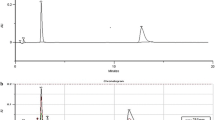Abstract
We report the identification of 11 impurities in variously stressed chlorhexidine digluconate (CHG) solutions. The structural assignment of each CHG impurity involved tentative identification from HPLC-MS data followed by synthesis of the appropriate standard, isolation of the impurity from the CHG solution by flash chromatography, and comparison of HPLC-MS, HPLC-UV, and NMR data of the impurity with the standard. Six of the synthetic impurity standards represent new compounds. Degradation studies of CHG solutions systematically stressed by heat, light, and low pH are reported with identification and approximate quantification of resulting impurities. Degradation mechanisms were proposed for each set of stress conditions applied to CHG solutions. Parallels were noted between the way CHG degrades in the thermospray interface of the HPLC-MS and the way CHG degrades with shelf time. Similarities were noted in the synthetic starting materials of CHG and the final degradation products.
Similar content being viewed by others
REFERENCES
F. L. Rose and G. Swain. Bisdiguanides having antibacterial activity. J. Chem. Soc. 4422–4425 (1956).
S. E. Davies, J. Francis, A. R. Martin, F. L. Rose, and G. Swain. 1,6-Di-4-chlorophenyldiguanidohexane (“Hibitane”). Laboratory investigation of a new antibacterial agent of high potency. Br. J. Pharmacol. 9:192–196 (1954).
Chlorhexidine in the prevention and treatment of gingivitis. H. Loe (ed). J. Periodont. Res. 21(Suppl. 16):1–89 (1986).
Chlorhexidine. In S. Budavari, M. J. O'Neill, A. Smithy, and P. E. Heckelman (eds.), The Merck Index, 11th ed., Merck and Co., Rahway, NJ, 1989, p. 323.
M. Hoang, J. F. Moellmer, and M. A. Khan. Separation of chlorhexidine breakdown products including 4-chloraniline in surgical scrubs containing chlorhexidine. J. Liq. Chromatogr. 13:2677–2687 (1990).
British Pharmacopoeia. Her Majesty's Stationery Office, London, England, 1973, p. 98.
M. Bauer, C. DeGude, and L. Mailhe. Simultaneous determination of chlorhexidine, tetracaine and their degradation products by ion-pair liquid chromatography. J. Chromatogr. 315:457–464 (1984).
L. Stevens, J. R. Durwachter, and D. O. Helton. Analysis of Chlorhexidine sorption in soft contact lenses by catalytic oxidation of (14C)chlorhexidine and by liquid chromatography. J. Pharm. Sci. 75:83–86 (1986).
C. Long, T. Martinez, L. Revelle, T. Layloff, and P. Reed. Comparison of the toxicity of contaminants found in commercial chlorhexidine formulations. Paper presented to Western Pharmacological Society Congress, Jan. 11 (1992).
W. C. Still, M. Kahn, and A. Mitra. Rapid chromatographic technique for preparative separations with moderate resolution. J. Org. Chem. 43:2923–2925 (1978).
R. M. Ladd and A. Taylor. Combining overload flash chromatography and high-resolution preparative liquid chromatography to isolate low-level synthetic bulk drug impurities. LC-GC 7:584–586 (1989).
K. J. Volk, R. A. Yost, and A. Brajter-Toth. Electrochemistry on line with mass spectroscopy. Anal. Chem. 64:21A–33A (1992).
H. M. R. Hoffman. The ene reaction. Angew. Chem. Int. Ed. Engl. 8:556–577 (1969).
V. G. Granik and S. I. Kaimanakoua. Advances in chemistry of amidines. Russ. Chem. Rev. 52:669–703 (1983).
J. M. Sayer and P. Conlon. The timing of the proton-transfer process in carbonyl additions and related reactions. General-acid-catalyzed hydrolysis of imines and n-acylimines of benzophenone. J. Am. Chem. Soc. 102:3592–3602 (1980).
S. K. Sethi, C. C. Nelson, and J. A. McCloskey. Dehalogenation reactions in fast atom bombardment mass spectroscopy. Anal. Chem. 56:1975–1977 (1984).
D. P. N. Satchell and R. S. Satchell. Acylation of ketens and isocyanates. A mechanistic comparison. Chem. Soc. Rev. 4:231–250 (1975).
W. Huber. Determination of carboxylic acid derivatives via acidic hydrolysis. Mikrochim. Acta 5:897–904 (1969).
D. E. Moore. Principles and practice of drug photodegradation studies. J. Pharm. Biomed. Anal. 5:441–453 (1987).
Author information
Authors and Affiliations
Rights and permissions
About this article
Cite this article
Revelle, L.K., Doub, W.H., Wilson, R.T. et al. Identification and Isolation of Chlorhexidine Digluconate Impurities. Pharm Res 10, 1777–1784 (1993). https://doi.org/10.1023/A:1018986501194
Issue Date:
DOI: https://doi.org/10.1023/A:1018986501194



